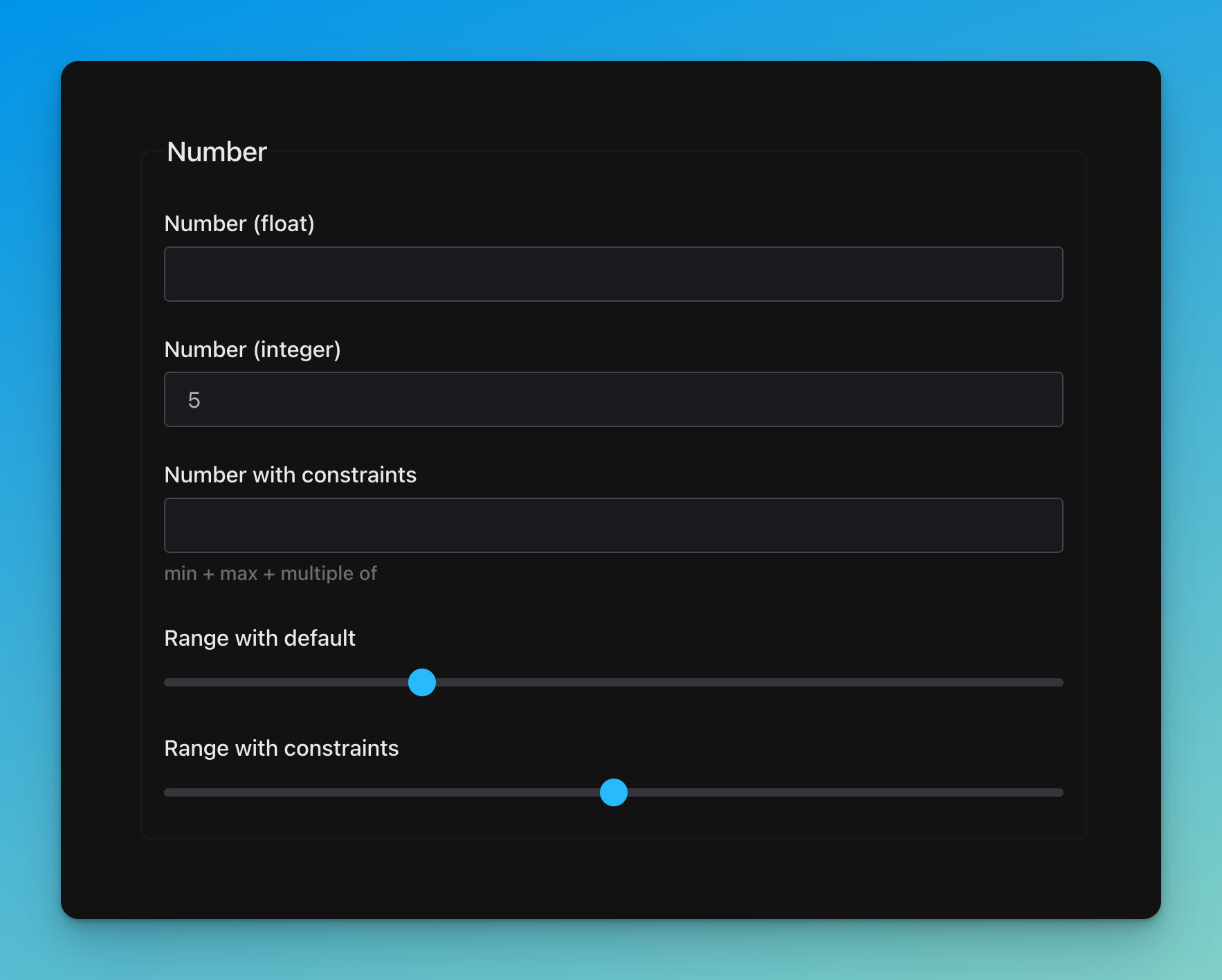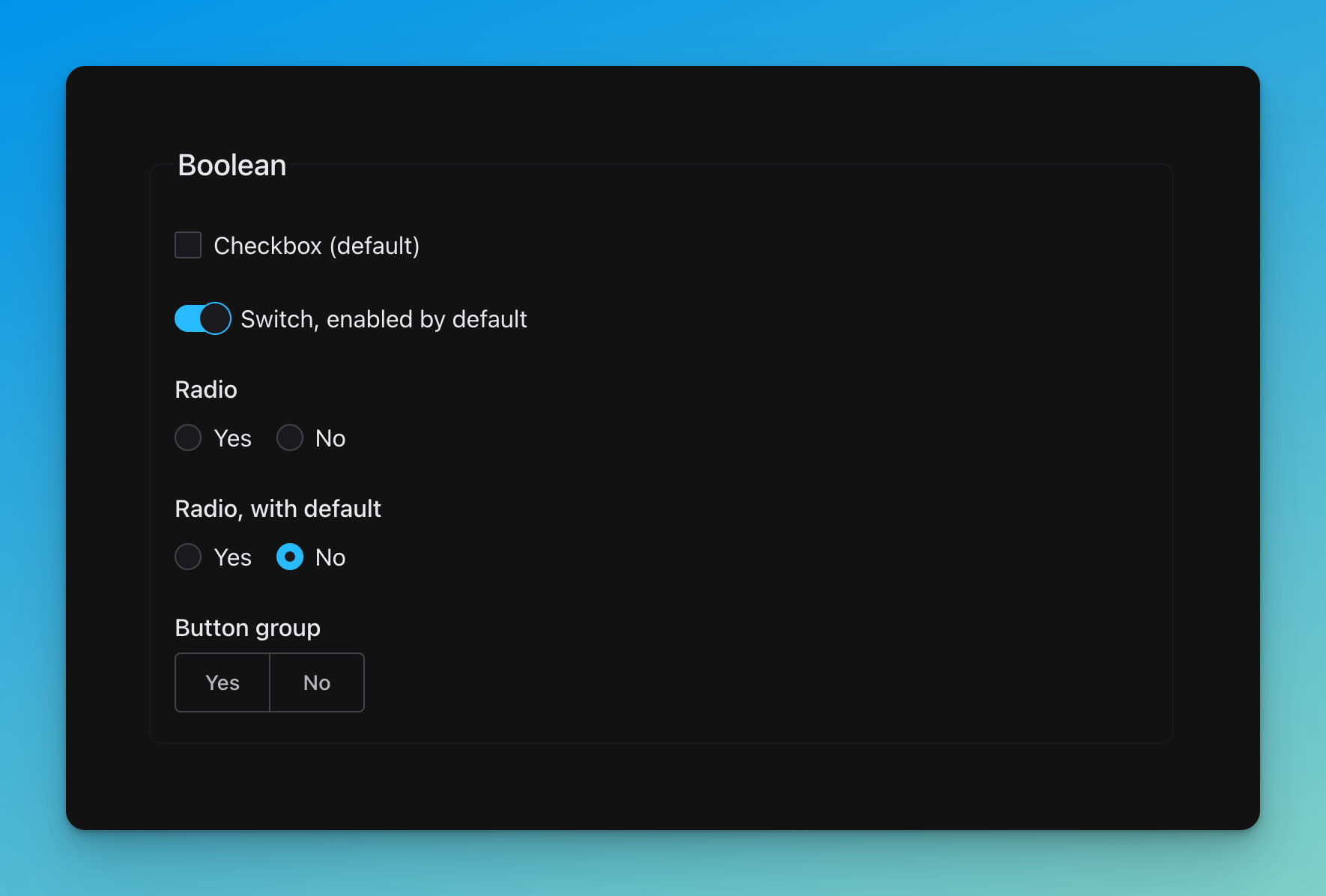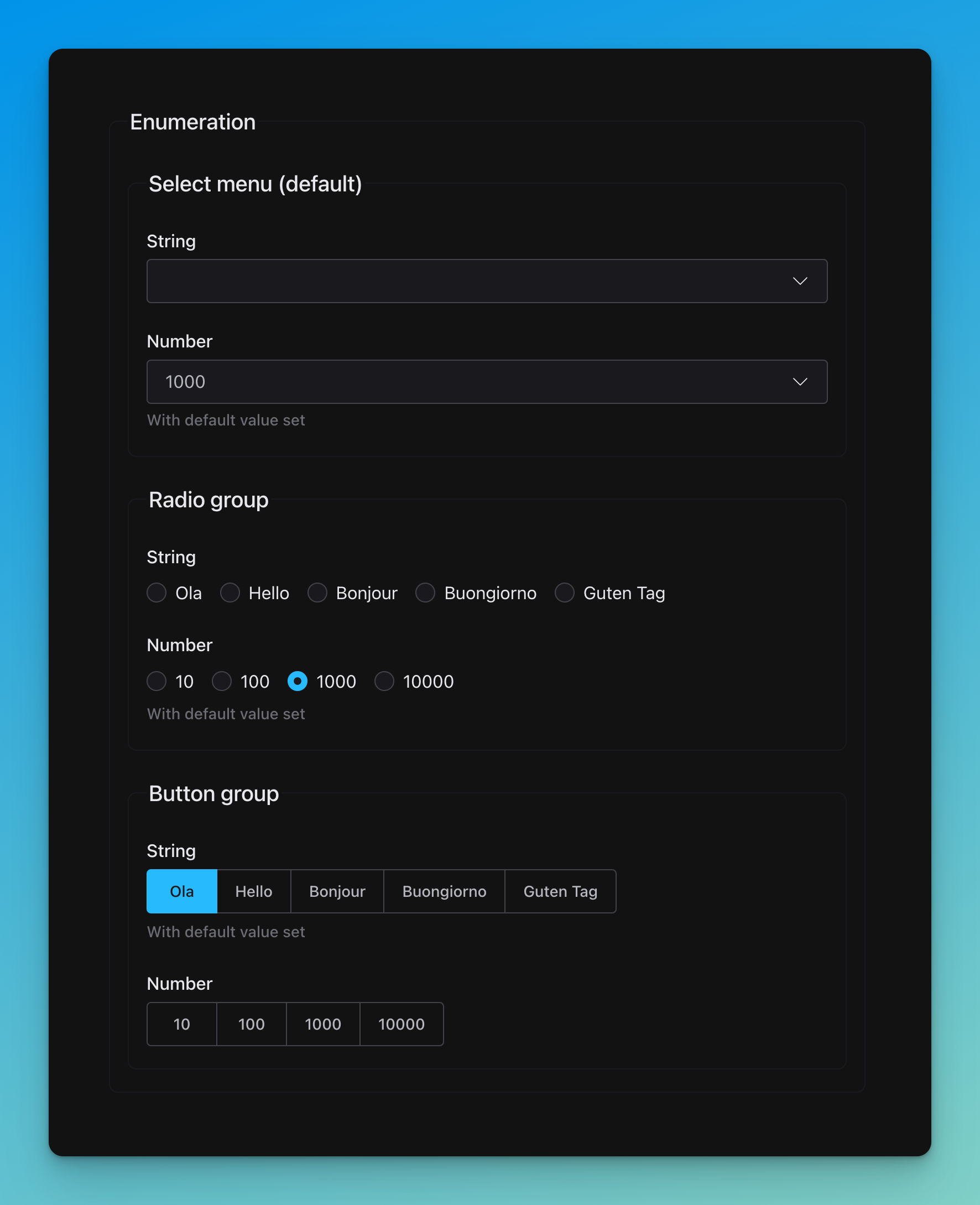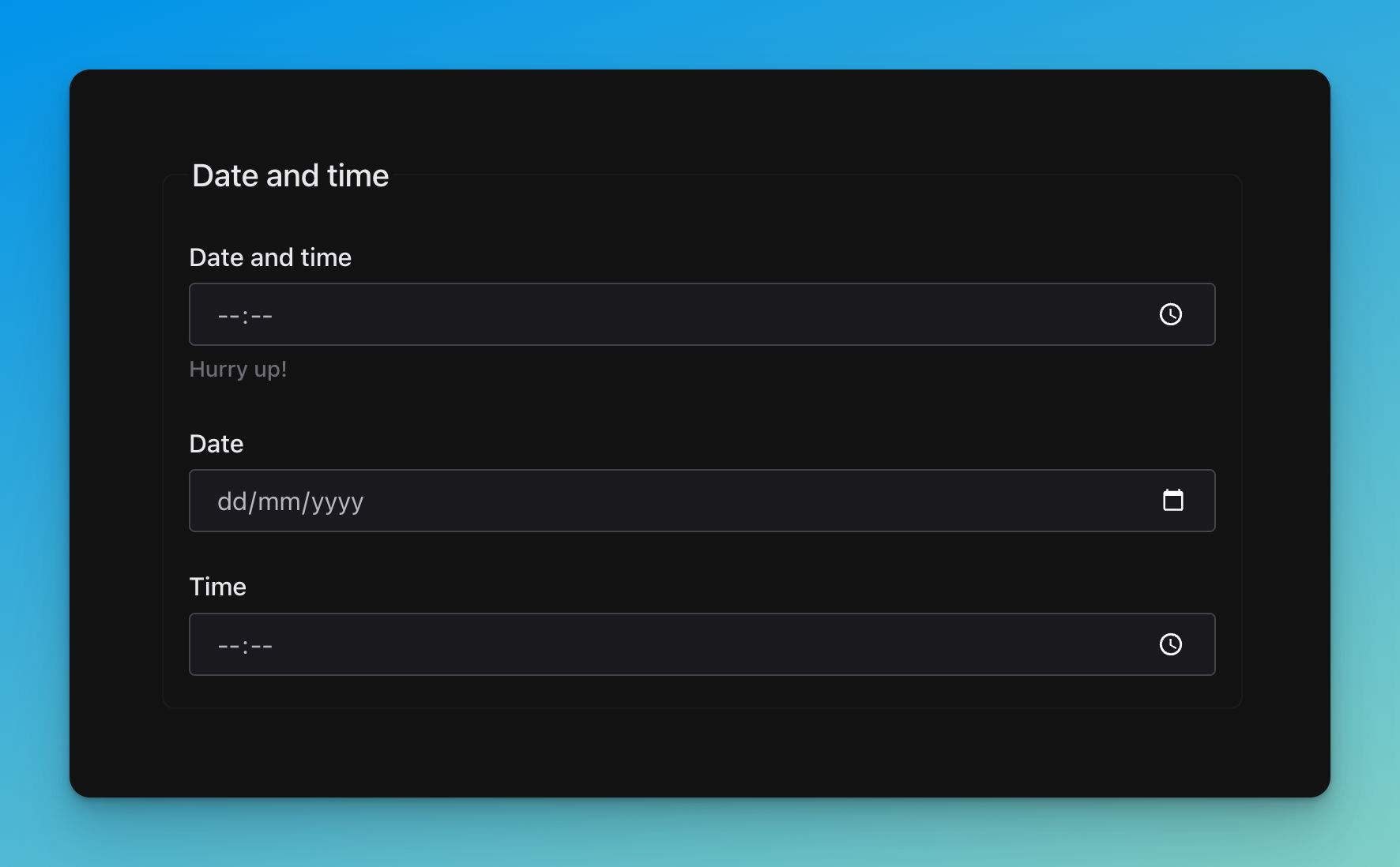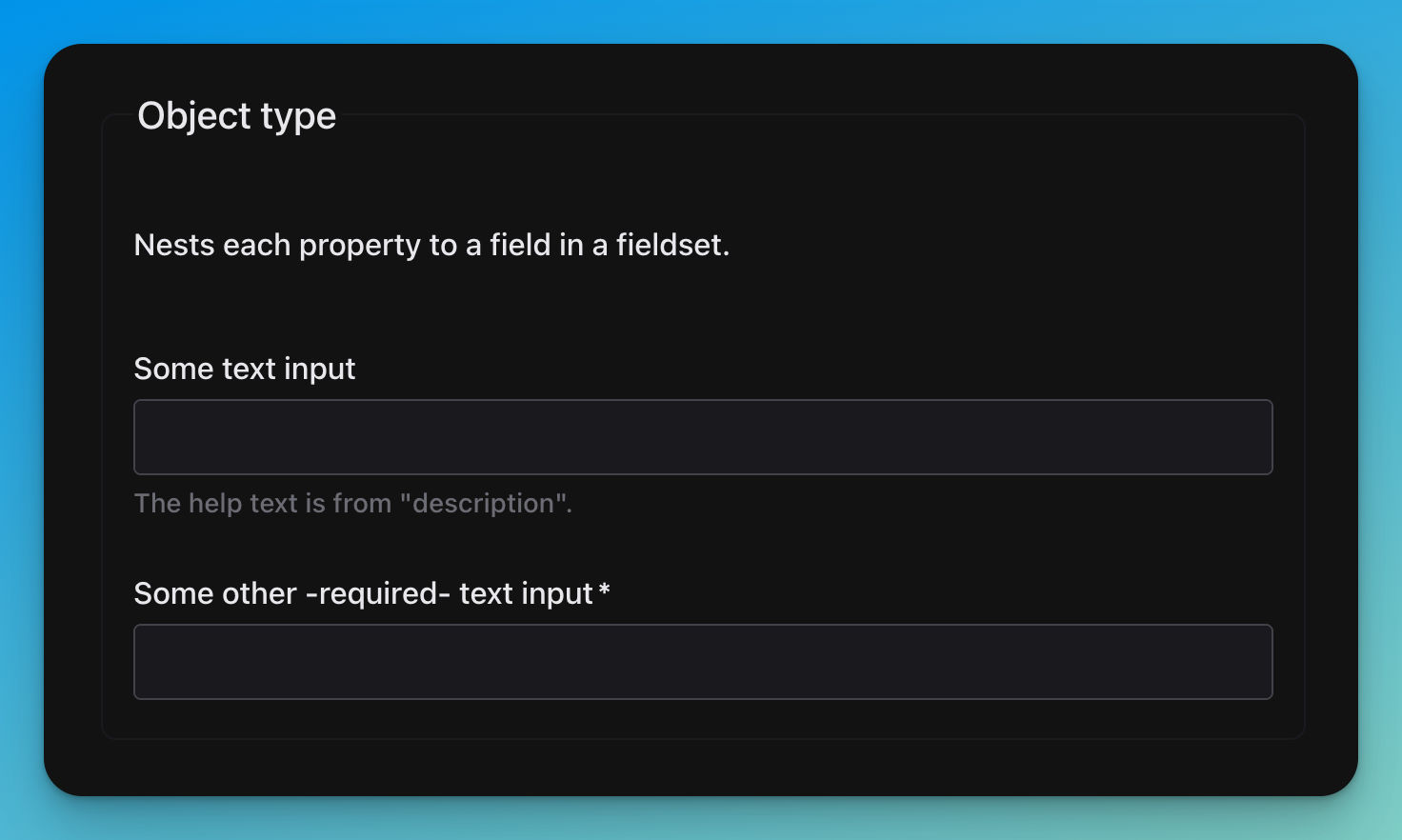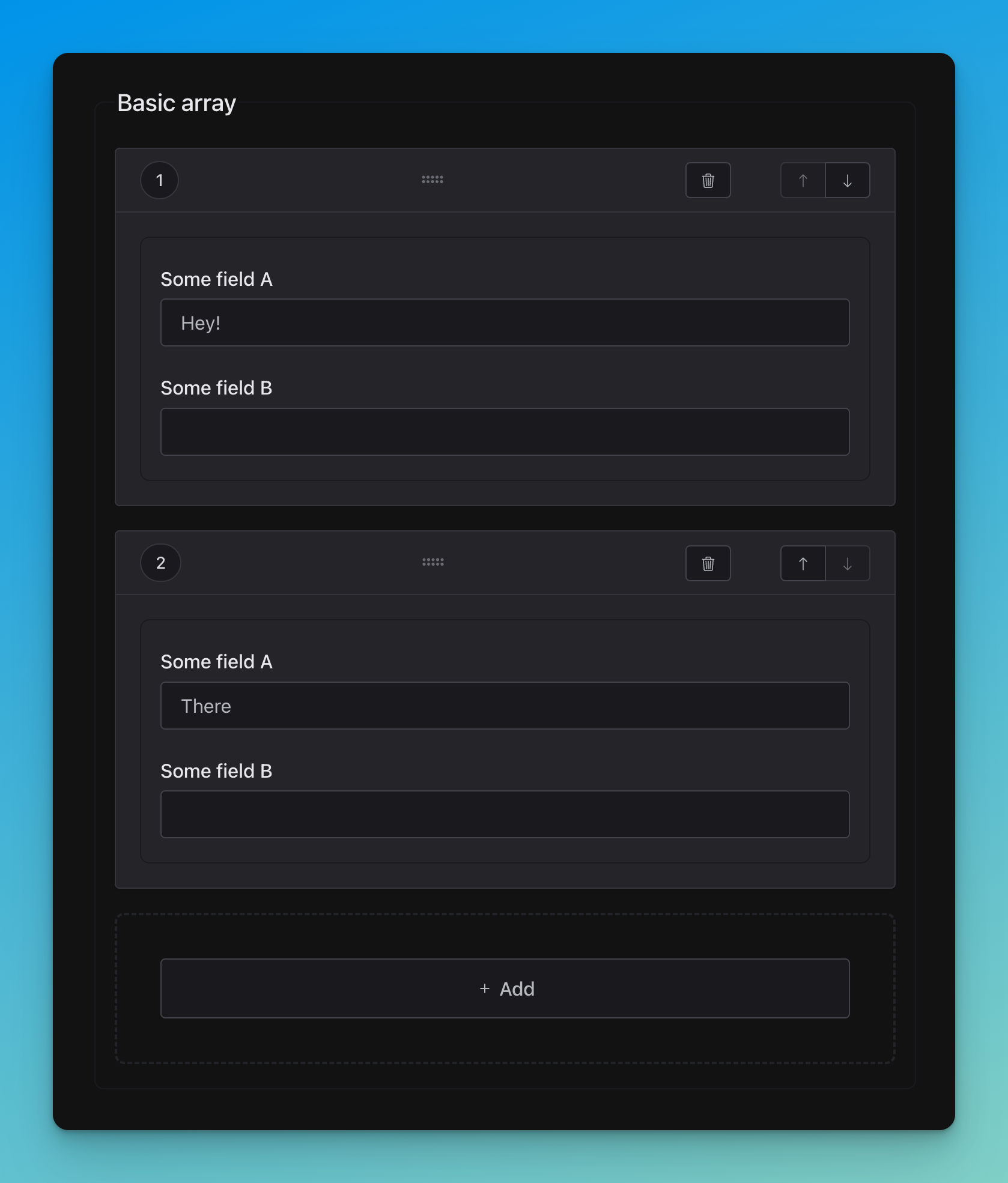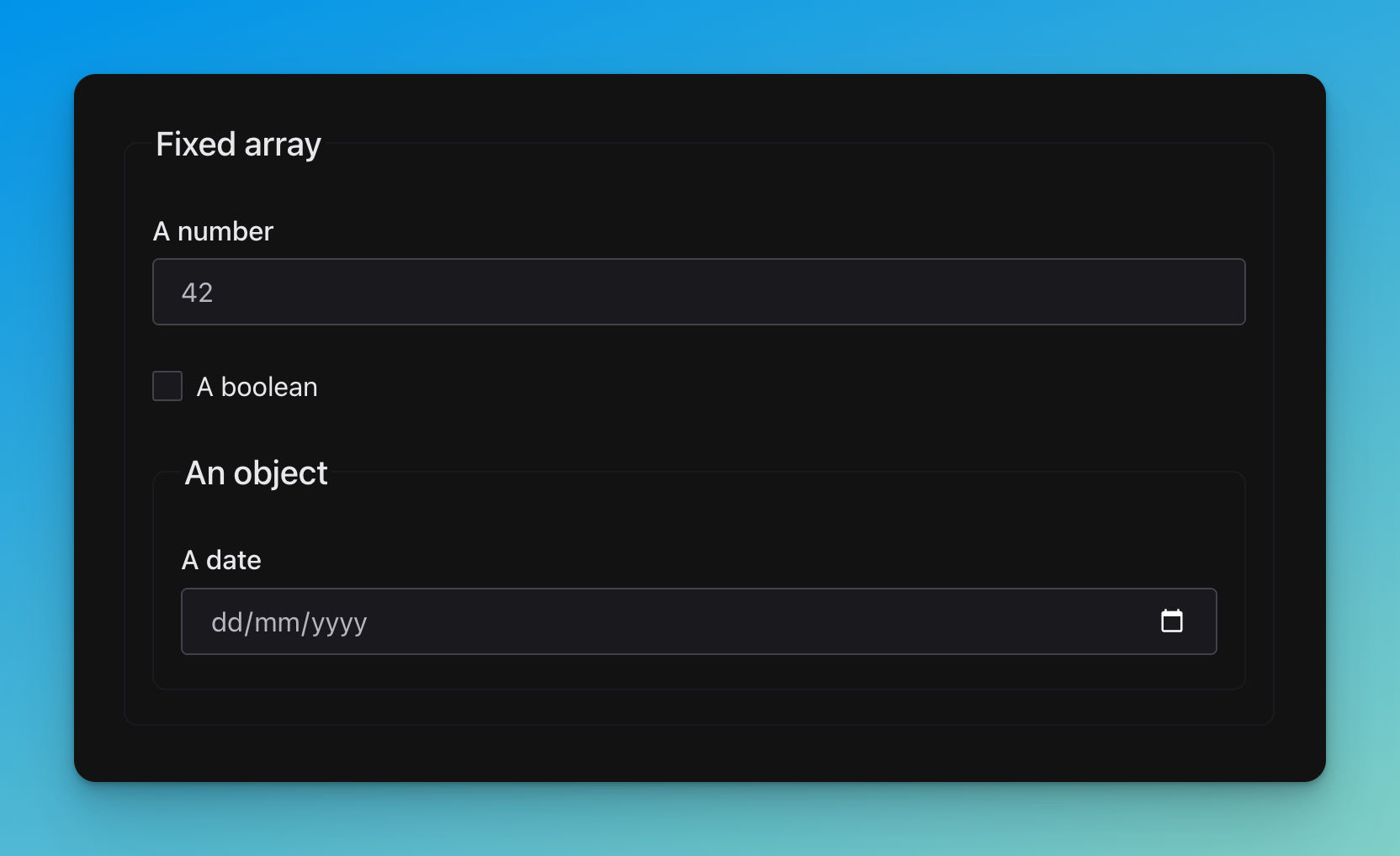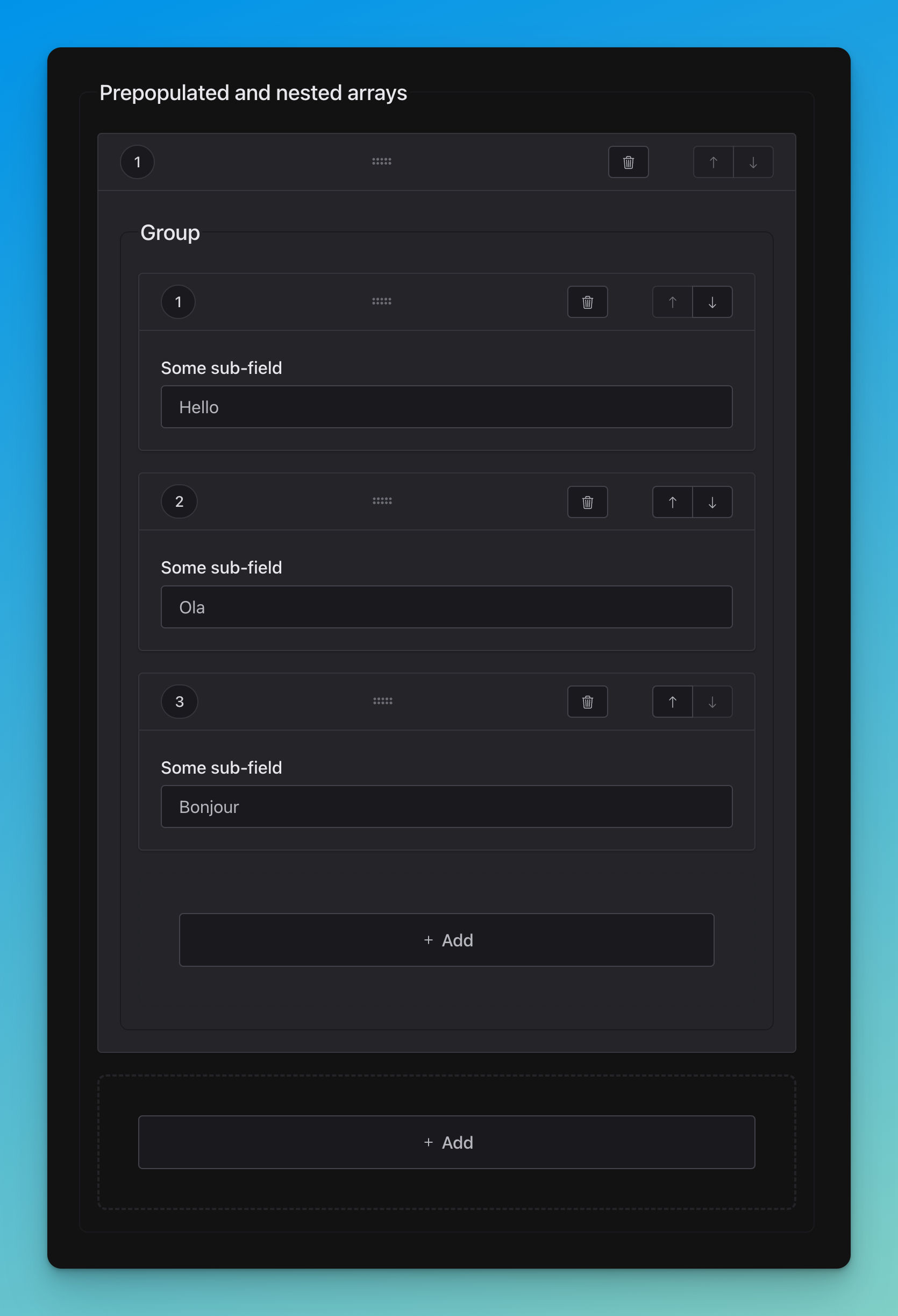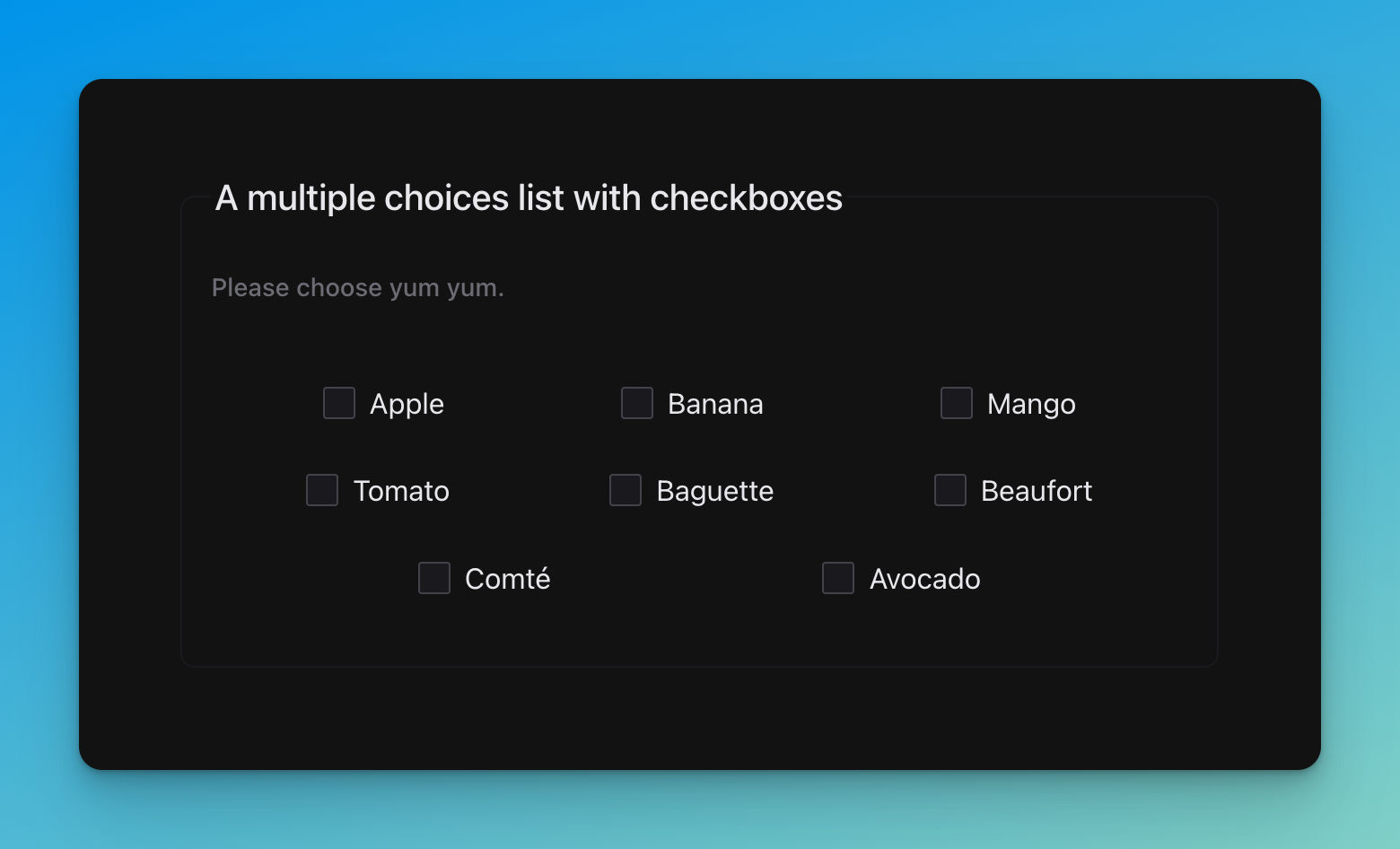Effortless forms, with standards.
Features:
- Instant form generation based on your JSON schemas.
- Integrates within your OpenAPI / JSON schema / MongoDB (BSON) stack.
- Comes with sensible defaults, while aiming for extensibility (themes, widgets…).
- ⚡️ Fast, and light 🪶.
Use cases:
- Quick CRUDs for you backends (JS, Python, PHP, Ruby…).
- Lightly interactive websites contact forms.
- Building block for custom CMSes.
- Building block for Markdown YAML frontmatter editors.
- Form builders… builder (🪆)
- You name it…
Due to their declarative and serializable nature, JSON schemas are highly interoperable and portable.
Moreover, UI schemas can be declared alongside to customize the view layer.
You can also override totally one ore more widgets, or just sprinkle some styles on top of the included ones.
Why?
While there is a handful of project for major frontend frameworks, there wasn't any Web Component packing all the features above.
Also if your are evaluating Web Component design systems or if you are building your own, this library is providing you a handy testbed.
See also the inspirations for this project.
Warning
Not for production
Jump to implementations:
— Pure HTML (CDN)
— TypeScript only (DOM)
— Astro (SSR) —
— Lit
— Solid
— Vue
— Svelte
— (P)React
—
🗂️ Table of Contents
title: String
required:
- stringConstrained
properties:
simpleString:
title: Simple inline string
type: string
default: With default value from schema
stringConstrained:
title: String with constraints
type: string
pattern: '^[A-Z \d\W]+$'
minLength: 2
maxLength: 10
description: Only UPPERCASE with 2 to 10 characters is allowed.
textArea:
title: Text area
description: Using UI schema options.
type: string
color:
title: Color picker
type: string
default: '#4a90e2'# UI schema
textArea:
'ui:widget': textarea
'ui:placeholder': This is a placeholder
color:
'ui:widget': colortitle: Number
properties:
float:
title: Number (float)
type: number
integer:
default: 5
title: Number (integer)
type: integer
numberConstrained:
title: Number with constraints
description: min + max + multiple of
type: integer
minimum: 50
maximum: 100
multipleOf: 10
range:
title: Range with default
default: 28
type: integer
rangeConstrained:
title: Range with constraints
type: integer
minimum: -50
maximum: 50
multipleOf: 25# UI schema
range:
'ui:widget': range
rangeConstrained:
'ui:widget': rangetitle: Boolean
properties:
checkbox:
title: Checkbox (default)
type: boolean
switch:
title: 'Switch, enabled by default'
type: boolean
default: true
radio:
title: Radio
type: boolean
radioWithDefault:
title: 'Radio, with default'
type: boolean
default: false
buttonGroup:
title: Button group
type: boolean# UI schema
switch:
'ui:widget': switch
radio:
'ui:widget': radio
radioWithDefault:
'ui:widget': radio
buttonGroup:
'ui:widget': button-grouptitle: Enumeration
properties:
select:
title: Select menu (default)
properties:
string:
title: String
type: string
enum: [Ola, Hello, Bonjour, Buongiorno, Guten Tag]
number:
title: Number
type: number
enum: [10, 100, 1000, 10000]
description: With default value set
default: 1000
radio:
title: Radio group
properties:
string:
title: String
type: string
enum: [Ola, Hello, Bonjour, Buongiorno, Guten Tag]
number:
title: Number
type: number
enum: [10, 100, 1000, 10000]
description: With default value set
default: 1000
buttonGroup:
title: Button group
properties:
string:
title: String
type: string
enum: [Ola, Hello, Bonjour, Buongiorno, Guten Tag]
default: Ola
description: With default value set
number:
title: Number
type: number
enum: [10, 100, 1000, 10000]# UI schema
radio:
string:
'ui:widget': radio
number:
'ui:widget': radio
buttonGroup:
string:
'ui:widget': button-group
number:
'ui:widget': button-grouptitle: Date and time
properties:
datetime:
title: Date and time
description: Hurry up!
type: string
format: date-time
date:
title: Date
type: string
format: date
time:
title: Time
type: string
format: timetitle: Object type
description: Nests each property to a field in a fieldset.
required:
- textBar
properties:
textFoo:
title: Some text input
type: string
description: The help text is from "description".
textBar:
title: Some other -required- text input
type: string🚧……🚧
title: Basic array
type: array
items:
properties:
textA:
title: Some field A
type: string
textB:
title: Some field B
type: stringtitle: Fixed array
type: array
items:
- title: A number
type: number
default: 42
- title: A boolean
type: boolean
default: false
- title: An object
properties:
when:
title: A date
type: string
format: datetitle: Prepopulated and nested arrays
type: array
items:
title: Group
type: array
items:
title: Some sub-field
type: string# Data
prepopulatedNested:
- - Hello
- Olatitle: A multiple choices list with checkboxes
description: Please choose yum yum.
type: array
uniqueItems: true
items:
type: string
enum:
- Apple
- Banana
- Mango
- Tomato
- Baguette
- Beaufort
- Comté
- Avocado🚧……🚧
🚧……🚧
🚧……🚧
🚧……🚧
🚧……🚧
🚧……🚧
🚧……🚧
🚧……🚧
🚧……🚧
🚧……🚧
npm i @jsfe/form
# or
pnpm i @jsfe/form
# or
yarn add @jsfe/formSee examples/src/pages/flavored.astro
Alternatively:
npm install @jsfe/shoelace
npm install @jsfe/material
npm install @jsfe/carbon
npm install @jsfe/wired
npm install @jsfe/system
<jsf-shoelace schema="..." uiSchema="..." data="..."></jsf-shoelace>
<jsf-material schema="..." uiSchema="..." data="..."></jsf-material>
<jsf-carbon schema="..." uiSchema="..." data="..."></jsf-carbon>
<jsf-wired schema="..." uiSchema="..." data="..."></jsf-wired>
<jsf-system schema="..." uiSchema="..." data="..."></jsf-system>See also the CSS section.
Warning
This project is new, API is subject to changes
You can try the multi-frameworks examples like this:
npx degit https://github.com/json-schema-form-element/examples jsfe-examples
cd jsfe-examples
npm i
npm run dev
|
Implementation |
Working sources |
Code sandbox |
|---|---|---|
|
|
|
|
|
|
||
|
|
||
|
|
||
|
|
||
|
|
||
|
|
||
|
|
Nowadays, there are many different strategies for CSS loading / bundling. JSFE is embedding its own style in its shadow, but for components libraries (here Shoelace) you should act depending on your current workflow.
References:
- https://lit.dev/docs/components/styles
- https://vitejs.dev/guide/features.html#css
- https://shoelace.style/getting-started/installation#light-and-dark-theme
Shoelace is embedding styles chunks accross components, however CSS custom properties are injected globally.
| API | No framework | Astro (SSR) | Lit | Solid | Vue | React / Preact | Svelte |
|---|---|---|---|---|---|---|---|
| Declarative control | ✅ | ✅ | ✅ | ✅ via prop: |
✅ | ❌ | ❌ (4) |
| Declarative inference | ❌ (1) | ❌ (2) | ❌ (3) | ✅ via prop: |
❌ | ❌ | ❌ |
| Declarative type-checking | ❌ (1) | ❌ (2) | ✅ | ✅ via prop: |
❌ | ❌ | ❌ |
| Imperative control | ✅ via DOM | - | ✅ via ref |
✅ via ref |
✅ via ref |
✅ via ref |
✅ via use: |
| Imperative inference | ✅ via DOM | - | ✅ via ref |
✅ via ref |
✅ via ref |
✅ via ref |
✅ via use: |
| Imperative type-checking | ✅ via DOM | - | ✅ via ref |
✅ via ref |
✅ via ref |
✅ via ref |
✅ via use: |
- HTML language servers can't support TypeScript obviously. But IDE can leverage Custom Element metadata.
- Astro JSX namespace / LSP are not handling
HTMLElementTagNameMapor Custom Element metadata, yet. - Template literals are preventing automatic properties inference, but at least, you can't assign wrong argument types without knowing it.
- Svelte heuristics are not clear regarding attributes versus properties handling. Better be safe than sorry. Also the
use:directive is neat.
There might be changes regarding support for Web Components accross various the various UI frameworks above. Please file an issue if an info is wrong or missing.
Each implementation examples are trying to show off the most type-safe way to use JSFE, with the least trade-offs.
Using it more declaratively or imperatively is up to you, your framework ability and you coding style.
Bot usages are valid and can be mixed. Typically when you want to use the schema elsewhere in your app., or
when your callbacks are getting too beefy, you'll better extract them from templates.
Generally, imperative usage get perfect TypeScript support (you just handle the class), whereas declaratively, you'll have to deal with various template languages limitations (this is an universal problem).
Shoelace is the UI component library of choice for rendering fields, and as a
general design system backbone for JSFE.
It's beautiful, aims for simplicity, is not too opinionated, while still having character.
That's why it's the very first library implemented in JSFE.
🚧……🚧
Support for Google Material 3 Web Components is planned.
🚧……🚧
It's totally doable to swap some or all components for another
system, thanks to the very Custom Element flexible nature.
First step would be to create a generic interface
for communicating with individual fields, starting with the raw system browser ones as a reference. That might add a fair amount of complexity and some (negligible?) performance impact though.
Main benefit could be to add some “missing” components in Shoelace, like
combobox, complex date-time ranges, or whatever fancy widget your dreaming of.
For example, React JSON Schema Form does support a handful of different UI libraries maintained by the community,
but AFAIK, in the Web Component space only Shoelace is on par, thanks its Lit backbone, all while beeing totally FLOSS.
Things are changing fast though, thanks to a growing WC ecosystem, with big names backing it up (Adobe, MS, Google, IBM, SpaceX… basically everyone).
For now, the JSFE component is one Lit Element monolith. All sub-parts are “partials“,
not individual Web Components. Those snippets are wrapping the Shoelace
components and make them aware and alive.
The validation logic / UI options are mostly happening there.
Choice has been made to tie the logic closely with the component.
While this practice should be avoided generally, here we have a fully declarative / programmatic UI, so no need to create more levels of indirection than needed.
Mapping between schema and “real” fields happens at the HTMLElement level, same as all validation stuff, though you got hooks / bypasses for custom behaviors (see below).
You're responsible to hook-up additional / more advanced validation with, e.g, AJV.
HTML native validation is already quite powerful, but you might want to do
your own wizardry.
Note that client-validation is more for user experience,
while server validation is here to ensure data integrity, provide context aware round-trips…
JSON schemas are easing up the constraints enforcement for moving data around, but you'll still have to manage traditional chores.
Good news is that they give you more time to take care of business related operations, UX…
Same as advanced validation handling above,
JSFE doesn't bundle, dereference, nor it is fetching remote
schemas.
Doing so would add a huge payload to the library, and you might certainly have already those tools at hand somewhere in your stack.
Only thing it does is resolving JSON references, pointing to local definitions only.
Implementation is quite simple, and because this is a much needed feature for DRY-ness, recursivity…
Hopefully it's easy to bring in an advanced parser along, like the json-schema-ref-parser.
See ./custom-elements.json & ./custom-elements.md
With internal dependencies included, minus peer dependencies (UI libs.):
| Package | Size | Version |
|---|---|---|
| @jsfe/form |  |
|
| @jsfe/shoelace |  |
|
| @jsfe/material |  |
|
| @jsfe/carbon |  |
|
| @jsfe/wired |  |
|
| @jsfe/system |  |
|
| @jsfe/types |  |
@jsfe/form contains the base class from which all other packages extends themselves from.
You don't need to install it, unless you want to provide widgets and styles from scratch.
If you just want to override some of the flavored components, @jsfe/<theme> packages are handy starters.
@jsfe/types contains everything for assisting your own widgets authoring.
It's re-exported from every package so you don't need to install it on your own.
You can try nightly builds from the next branch like this: npm i @jsfe/<package>@next.
To activate experimental features preview flags, just pass the experimental property.
E.g. with Lit:
html`<json-schema-form
otherProps="..."
.experimental=${{
'<flag>': true,
// ...
}}
></json-schema-form>`;Actual features flags list:
allOfoneOf
- BYOC (bring your own components).
- Extensive and modern JSON Schema support (identify Draft 4 / 7 / 2020 subtleties).
- Nice file uploaders for the
data-urlformat. - Layout customizations
- Tests, browser based (due to the WC nature).
- Tests, tests, even more tests in the field to reveal shortcomings.
- Drag and drop: improve the initial implementation (E.g. cross-nested arrays).
- Autofocuses (for added array item, etc.)
- …
- Have an idea? Discussions are open!
The Web Component and JSON Schema communities, the Lit team, the Shoelace maintainers,…
As a workhorse for many projects of mine for a long time, I'm grateful for all the ideas RSJF creators brought.
Similar projects:
See also:
- remark-lint-frontmatter-schema: Validate your Markdown frontmatter data against a JSON schema.
- retext-case-police: Check popular names casing. Example:
⚠️ github→ ✅GitHub. - astro-openapi: An Astro toolset for building full-stack operations easily, with type-safety and documentation as first-class citizens.













